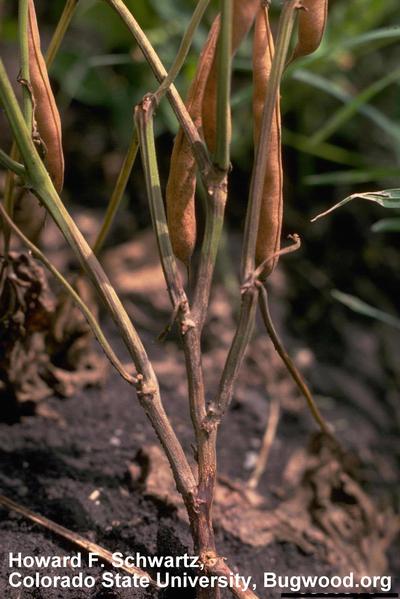Dry Root Rot
Macrophomina phaseolina
Fungus
5 mins to read
In a Nutshell
- Dry root rot disease is more dominant when the crop is exposed to moisture stress conditions.
- It can contribute to 50 - 100% yield loss under favorable conditions.
- The pathogen is both seed-borne and soil-borne.
- Symptoms are obvious during post-flowering stage: drooping and chlorosis of petioles and leaves.
Can also be found in
Symptoms
In chickpea fields, the onset of the disease appears as scattered drying of the plants. The first symptoms of the disease are yellowing and drying of the leaves. These infected leaves usually drop within a day or two and the whole plant dies in the next two or three days. The leaves and stem of the affected plants are usually straw-colored however in some cases, the lower leaves and stems show brown discoloration. The taproot is dark and quite brittle in dry soil.
Recommendations

Organic Control
Leaf, trunk, bark, fruit pulp and oil extracts such as aqueous extracts and oil of Neem inhibit the growth of soil-borne pathogen M. phaseolina. Antagonistic pathogenes/ bio-control agents like Trichoderma viride and Trichoderma harzianum are helpful in reducing the incidence of the disease. Apply a combination of T. harzianum + P. fluorescence (both @ 5g/kg seed) for seed treatment followed by soil application of enriched T. harzianum + P. fluorescence @ 2.5kg/250kg of Farm Yard Manure (FYM) during sowing.

Chemical Control
Always consider an integrated approach with preventive measures and biological treatments, if available. Chemical control of dry root rot is not effective, as M. phaseolina has a broad host range and survives in soil for longer periods of time. Seed treatment by fungicides is effective to some extent in reducing losses in chickpea which are particularly vulnerable at the seedling stage. Fungicide seed treatments with carbendazim and mancozeb followed by soil drenching can reduce the incidence of the disease significantly.
What caused it?
It is a soil-borne disease initiated by soil-borne fungal threads or spores of the fungus Macrophomina phaseolina. The symptoms appear suddenly when ambient temperatures are between 30 - 35°C . With the rise in temperature and more frequent moisture stress, the fungus becomes more intense in typically tropical humid areas. The disease generally appears during late flowering and podding stages, leaving the infected plants to appear completely dried. In the absence of the host crop, it survives in the soil as a competitive saprophyte on available dead organic matter. M. phaseolina can cause 50 - 100% yield loss under favorable conditions.
Preventive Measures
- Select tolerant varieties, if available.
- Sow early maturing varieties to avoid high temperature during maturity, thereby reducing infection.
- Monitor the field regularly for symptoms of the disease.
- Maintain good soil moisture.
- Plow deeply and remove infected plant debris from the soil and destroy them.
- After harvest, use soil solarization to disinfect your soil.
- Cultivate your crop in raised beds and furrow it before planting.
- Plan a 3-year crop rotation with non-hosts crops, for example, sorghum or fenugreek.



